Tradition!
...Not just chopped liver.
Jewish families and their friends in the Triangle gather round the table every spring to mark Passover, which celebrates freedom by commemorating the escape from slavery in ancient Egypt. Here are recipes for the holiday feast from five recent cookbooks.
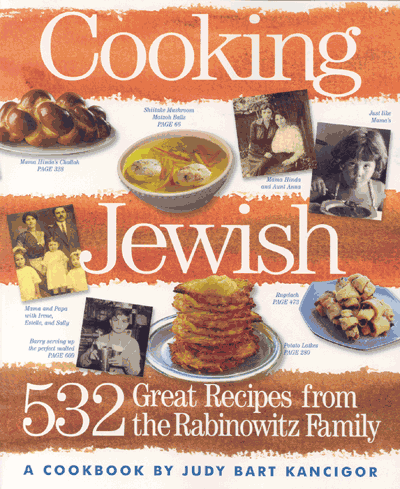
Chicken Soup
Open letter to my cousins: Many of you claimed that your mother’s chicken soup is the best. My mother’s made the final cut for two reasons. First of all, this cookbook was my idea, and when you write your cookbook, you can say your mother’s is the best! Second, I am including it because it really is the best, and anyone who disagrees either has never had my mother’s chicken soup or is congenitally tastebud challenged.
2 chickens (3- to 4 pounds each) with giblets (no liver) quartered
2 pounds carrots
2 large onions cut in half
5 large ribs celery with leaves cut in half
2 large parsnips
1 small sweet potato (6 ounces), cut in half
1 turnip (6 ounces), cut in half
1 rutabaga (6 ounces), cut in half
1 small celery root cut in half (optional)
1/2 large green bell pepper, stemmed and seeded
1/2 large yellow pepper, stemmed and seeded
2 large bunches dill coarsely chopped (about 1- cups)
1/2 bunch curlyleaf parsley (about cup)
3 cloves garlic
Kosher (coarse) salt and freshly ground black pepper to taste
Chopped dill, for serving (optional)
Place the chicken in a 16-quart stockpot and add water to barely cover. Bring just to the boiling point. Then reduce the heat to a simmer and skim off the foam that rises to the top.
Add all the remaining ingredients (except the optional chopped dill) and only enough water to come within about two-thirds of the height of the vegetables in the pot. (Most recipes will tell you to add water to cover. Do not do this! You want elixir of the gods or weak tea? As the soup cooks, the vegetables will shrink and will be covered soon enough. Eight to 10 cups of water total is plenty for this highly flavorful brew.) Simmer, covered, until the chicken is cooked through, about 1-1/2 hours.
Remove the chicken and about half the carrots from the pot, and set them aside.
Strain the soup through a fine-mesh strainer into another pot or container, pressing on the vegetables to extract all the flavor. Scrape the underside of the strainer with a rubber spatula and add the pulp to the soup. Discard the fibrous vegetable membranes that remain in the strainer. If you’re fussy about clarity (and we’re not), you can strain it again through a fine tea strainer, but there goes some of the flavor. Cover the soup and refrigerate overnight.
When you’re ready to serve the soup, scoop the congealed fat off the surface and discard it. Reheat, adding more dill if desired (and we do). Slice the reserved carrots, add them to the soup, and serve.
Makes about 3 quarts.
Matzo Balls
The world is divided into those who love floaters and those who love sinkers. While the delicate floaters are favored by matzo ball mavens everywhere, I am a closet sinker lover, which is the way my father’s mother, Grandma Ruchel, made them. Which is not to say I haven’t gobbled with gusto a floater or two in my day. Aunt Irene’s are definitely floaters. Some say club soda makes for a lighter “knaidel.” Cooking them longer will make them lighter, too.
2 tablespoons melted chicken fat, melted shortening or vegetable oil
2 large eggs, lightly beaten
cup matzo meal
1 teaspoon kosher salt
1 teaspoon baking powder
2 tablespoons club soda, chicken broth or water
Blend the fat and eggs together in a small bowl. Add the matzo meal, salt and baking powder and blend well. Add the club soda and mix thoroughly. Cover and refrigerate until the mixture is firm, at least 1 hour.
Bring a large pot of water to a boil, and lightly salt it.
Using wet hands, form the mixture into balls (2 tablespoons each for 2-inch matzo ball, 1 tablespoon for 1-1/2 inch), and carefully drop them into the boiling water. Do not crowd the pot. Cover the pot and cook at a slow, steady boil (not a hard boil) until soft, 30 to 40 minutes.
Remove the matzo balls with a slotted spoon, and serve in soup.
Makes about 8 large or 16 small matzo balls.
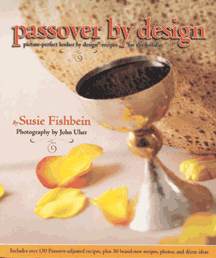
Roasted Garlic Chicken Stuffed with Dried Fruits and Nuts
1 head garlic
Extra virgin olive oil
Fine sea salt
Freshly ground black pepper
10-12 dried apricots
5 dried mission figs
cup shelled, raw pistachio nuts (unsalted and
not roasted)
1 whole (3-5 pound) chicken or pullet, washed and patted dry
orange, unpeeled, sliced
2 sprigs fresh rosemary
Kitchen twine
3 tablespoons margarine, melted
Preheat oven to 375 degrees.
Holding the head of garlic on its side, cut 1 to 2 inches off the top of the bulb to expose the cloves. Place the head into the center of a square of foil on a small baking pan. Drizzle with olive oil and season with salt and pepper. Close the foil packet. Roast for 45 minutes to 1 hour until soft, golden and fragrant.
Meanwhile, in a food processor fitted with a metal blade, chop the apricots, dried figs, and pistachios into very small pieces.
With your finger, loosen the skin of the chicken, going under the skin of the breasts, thighs and legs. Massage the fruit mixture under the skin, getting it into cavities where the skin was loosened.
Stuff orange slices and rosemary into the cavity of the chicken. Tie the legs closed with kitchen twine. Place the chicken on a rack in a roasting pan; try not to let too much of the fruit and nuts drip out into the pan or they will burn.
When the garlic is soft and caramelized, remove it from the oven and squeeze the roasted garlic from the skin onto a cutting board. Mash the garlic with the back of a knife to make a smooth paste. Rub it all over the outside of the chicken.
Drizzle the margarine over the top of the chicken, letting it run down the sides.
Tent with aluminum foil. Bake, covered, for 1 hour and 15 minutes, basting 2 to 3 times with the pan juices. Uncover and roast until the skin is brown, watching to make sure the garlic doesn’t burn.
Note: You can prepare this dish with chicken parts as well. Lay the orange slices and sprigs of rosemary in your baking pan. Place the stuffed chicken pieces on top.
Makes 4 servings.
Vegetable Puree
You will get rave reviews on this healthy, low-carb substitute for whipped potatoes. It turns a simple vegetable into a delicious and visually appealing treat.
2- pounds fresh cauliflower florets, chopped
5 cloves fresh garlic, sliced
1- cups chicken stock
2- teaspoons kosher salt
8 tablespoons nondairy creamer
5 teaspoons margarine
Freshly ground black pepper
In a large pot, place the cauliflower, garlic, chicken stock and salt. Bring to a boil. Cover and reduce to medium heat. Simmer about 10 minutes or until cauliflower is very tender.
Transfer the pot contents to the bowl of a food processor fitted with a metal blade. Add the nondairy creamer and margarine. Process until smooth. Season with black pepper.
Note: The recipe is written for cauliflower, but can be prepared with carrots as well. Just use 8 peeled and sliced carrots and let simmer longer.
Makes 8 servings.
Slow-Braised Brisket with Rosemary, Shallots and Red Wine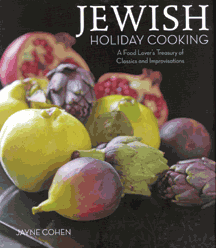
Whenever I am asked what is the best way to make a brisket, I am stumped. Sure, there are techniques I always rely on. I sear it thoroughly, then slowly oven-braise the burnished meat with aromatics. When it emerges deeply flavored and fork-tender, I let it rest a long while in the pan sauce, reabsorbing the rich juices lost during cooking, to eliminate the dryness endemic to the cut. The sauce, defatted first, is pureed, then cooked down to concentrate the luscious flavors.
For the flavor paste:
6 large garlic cloves, chopped
2 tablespoons fresh rosemary leaves
1 tablespoon fresh lemon juice
1 teaspoon kosher salt
1/4 teaspoon freshly ground black pepper
A first- or second-cut beef brisket, 4 to 5 pounds, trimmed of excess fat, wiped with a damp paper towel, and patted dry
For the braising:
2 tablespoons olive oil
3 cups coarsely chopped shallots
2 cups full-bodied dry red wine
1 or 2 canned whole plum tomatoes, seeded and coarsely chopped
8 large garlic cloves, peeled
Three 3-inch fresh rosemary sprigs, plus 1 teaspoon finely chopped leaves
Four 4-inch fresh thyme sprigs, plus 1 teaspoon leaves
3 cups beef stock
Salt and freshly ground black pepper
Process the paste ingredients in a blender or mini food processor to a coarse puree.
Make a slit in the fat side of the brisket with the point of a small, sharp knife. Insert a little of the paste into the slit, using your fingers and the knife tip to push it in as far as possible. In the same way, insert some of the paste all over the top, bottom and sides of the brisket, spacing them out as evenly as you can. Rub the remaining paste into the outside of the meat.
Place the brisket in a large, plastic resealable bag or wrap it tightly in plastic wrap, and refrigerate it for a minimum of 8 and up to 24 hours, so the flavorings can penetrate the meat.
Remove the meat from the refrigerator and bring it to room temperature. Scrape off the paste and pat the meat dry with paper towels.
Preheat the oven to 275 degrees.
In a Dutch oven or flameproof roasting pan large enough to hold the brisket snugly, heat the oil over medium-high heat. (If using a roasting pan, you may need to set it over two burners.)
Add the brisket, and brown well on both sides. (This will take about 10 minutes in all). Sear to caramelize the meat, but don’t let it develop a hard, brown crust, which might make the meat tough or bitter.
Transfer the brisket to a platter and set aside. (Or sear under the broiler: place the brisket fat side up, on a foil-lined broiler pan, under a preheated broiler. Broil for 5 to 6 minutes on each side, until browned. Don’t allow it to develop a hard, dark crust. Move the meat around as necessary, so it sears evenly.)
Pour off all but 1 tablespoon of the oil remaining in the pan, and add the shallots. Saute over moderately high heat, stirring, for 3 to 4 minutes.
Add 1 cup of the wine, raise the heat to high, and bring to a boil, scraping up any browned bits from the bottom of the pan with a wooden spoon. Boil the mixture until the pan liquid is reduced to a glaze. Add the tomatoes, garlic, rosemary and thyme sprigs, beef stock and the remaining wine. Boil for a few minutes, then lower the heat to a simmer.
Salt and pepper the brisket to taste on both sides, and add it to the pan, fat side up. Spoon the vegetables and pan liquid all over the meat. Cover the pan tightly (use heavy-duty foil if you don’t have a lid for the roasting pan) and place in oven.
Braise the meat, basting with the pan sauce and vegetables every half hour, for 3 to 3-1/2 hours or more, until the meat is fork-tender.
Remove the pan from the oven and cool for 1 hour, then refrigerate, covered, overnight, in the braising liquid.
Scrape off all the solid fat from the surface of the meat and braising liquid. Transfer the brisket to a platter and cut into thin slices across the grain at a slight diagonal.
Warm the braising liquid to room temperature. Remove thyme and rosemary sprigs and discard.
In a food processor or a blender in batches, puree the pan solids with some of the braising liquid. Return this mixture to the pan and bring to a simmer. Season with salt and pepper. If the gravy is too thin, boil it down to desired consistency over high heat. Stir in the rosemary and thyme leaves.
Return the sliced brisket to the pan and reheat slowly, either on top of the stove or in a 325-degree oven, until heated through.
Arrange the meat on a serving platter with some of the gravy spooned over the meat. Pass the rest of the gravy in a sauce boat at the table.
Makes 8 generous servings.
Salad of Bitter Herbs and Oranges
This salad, combining several of these bitter herbs with chunks of fresh orange, offers a lovely contrast to a lush brisket or braised lamb.
For the dressing:
cup fresh lemon juice
2 tablespoons minced shallot
1- tablespoons chopped fresh thyme
2 teaspoons grated orange zest
1 cup extra virgin olive oil
Salt and freshly ground black pepper
For the salad:
12 to 14 cups mixed greens (choose 3 or more of the following: arugula, sorrel, watercress, Belgian endive, romaine, radicchio)
cup thinly sliced radishes
4 to 6 thinly sliced scallions (use white and pale green parts)
cup snipped fresh dill
2 blood or navel oranges, peeled and white pith removed, quartered lengthwise and sliced widthwise
Combine the lemon juice, shallot, thyme and zest in a medium bowl. Gradually whisk in the oil. Season with salt and pepper.
Place the greens in a large bowl. Top with the radishes, scallions and dill. Toss with enough of the dressing to coat. Add the oranges and toss again.
Makes 8 servings.
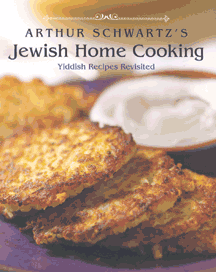
Matzo Buttercrunch
This recipe was created by Marcy Goldman of Montreal and was published in her book “A Treasury of Jewish Holiday Baking.” She had disseminated it long before that, however, on her Web site, www.BetterBaking.com. Now I see it published (unfortunately not credited) in New York City newspapers and national magazines, and passed around by New Yorkers who claim it as their own. Taking credit for this confection where it is not due is understandable. The recipe is fabulous, although over the years, I have added more chocolate to Marcy’s recipe, and I have changed the directions slightly. Marcy’s inspiration was a standard old American recipe that uses soda crackers to make a similar candy, but without the chocolate and nuts.
4 to 6 unsalted matzo boards
1 cup unsalted butter or margarine
1 cup firmly packed brown sugar
12 ounces semisweet chocolate chips, or semisweet chocolate, coarsely chopped
Preheat the oven to 375 degrees. Line a baking sheet completely with aluminum foil. Lay parchment paper on top of the foil. This is very important, as the mixture becomes sticky during baking.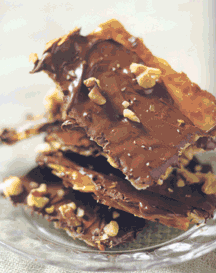
Line the bottom of the pan evenly with the matzo boards, cutting extra pieces of matzo, as required, to fit any uncovered spaces.
In a 3-quart, heavy saucepan, combine the butter and brown sugar and cook over medium heat, stirring constantly, until the mixture comes to a boil. Continue boiling 3 more minutes, stirring constantly. Remove from the heat and immediately pour over the matzo.
Place the matzo candy in the oven and immediately reduce the heat to 350 degrees. Bake for 15 minutes, checking after 10 minutes to make sure the mixture is not burning. Remove from the oven and immediately sprinkle the matzo with chopped chocolate. Let stand 5 minutes, then, with an offset spatula, spread the melted chocolate evenly over the matzo.
While still warm, cut the candy into squares or odd shapes. I just break it into pieces. Chill in the refrigerator until set. Covered tightly with plastic, it should keep for several weeks in the refrigerator. Bring back to room temperature to serve.
Variations:
• Use white chocolate, coarsely chopped (or both white and dark chocolates).
• Sprinkle chopped toasted nuts — almonds, hazelnuts, walnuts or pecans over the chocolate.
• If you prefer granulated sugar, follow these directions for a no-bake version: Arrange the matzo on the lined baking sheet as described in the recipe. Place 2 cups granulated sugar and 2 tablespoons water in a heavy-bottomed saucepan. Heat on medium low until the sugar dissolves. Continue cooking until the mixture turns medium amber in color. Pour over the matzo. Sprinkle with chocolate and spread as directed.
Makes one 12x15-inch sheet.
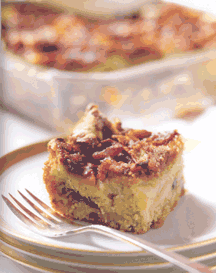 Apple Cake
Apple Cake
When it was given to me, this recipe originally specified flour, not matzo cake meal. I didn’t think it was very good, but I made it a few times anyway, as my family and friends liked it. Obsessing over how to improve the recipe to make it more to my own liking, it dawned on me that someone had converted a perfectly good Passover cake into an everyday cake and that if I converted it back it would be much better. I love it now, and everyone I have served it to raves about it. One day I didn’t have quite enough ground cinnamon, however, and I blended together a substitute with the teaspoon of cinnamon I had, plus ground nutmeg, mace and ginger to fill out the tablespoon measure. That was yet another improvement.
For the topping:
cup coarsely chopped walnuts or pecans
cup sugar
1 tablespoon ground cinnamon or a combination of ground cinnamon,
nutmeg, mace and ginger
For the cake:
3 eggs
cup sugar
cup vegetable oil
cup matzo cake meal
5 medium apples, peeled, cored, halved, and cut into -inch thick slices (about 5 cups), preferably Golden Delicious, Crispin (Mutzu) or other apples that keep their shape when cooked
cup raisins (optional)
Position an oven rack in the center of the oven. Preheat the oven to 350 degrees. Lightly oil an 8-inch, square, glass baking dish.
To prepare the topping, mix together the walnuts, sugar and cinnamon in a small bowl; set aside.
To prepare the cake batter, in a bowl, with a hand-held electric mixer, beat the eggs on medium speed until well mixed. Beat in the sugar, about 2 tablespoons at a time, beating until the mixture is thick and foamy. Beat in the oil, adding it in a steady stream. Scrape down the bowl with a rubber spatula. With the spatula, stir in the matzo cake meal, blending well.
Pour half of the batter mixture into the prepared pan. Sprinkle about half the topping mixture evenly over the batter. Top with half the apples and all the raisins. Scrape the remaining half of the batter over the apples, spreading it out to cover the apples. Arrange the remaining apples on top of the batter. Sprinkle evenly with the remaining topping mixture.
Bake for 1 hour and 15 minutes, or until the sides of the cake pull away very slightly from the baking dish and the topping has begun to caramelize. (A cake tester is not reliable. It will not come out clean due to the moist richness of this cake.) Let sit in the baking dish for several hours until completely cool before cutting into serving portions.
Makes one 8-inch square cake.
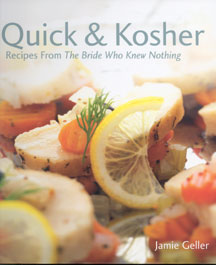
Homemade Chocolate Fondue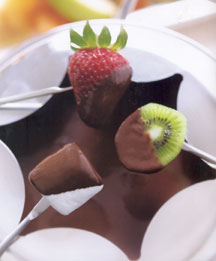
My mom didn’t hit the stove too often while my sister and I were growing up, but fondue was her forte. She always wanted to make sure we ate enough fresh fruits and vegetables, and fondue was her way of luring us to a fruit salad.
For the fondue:
cup unsweetened cocoa powder
cup sugar
cup margarine
cup liquid nondairy creamer
For dipping, choose any or all of the following:
Fresh fruit
Dried fruit
Marshmallows
Brownies
Soft, chewy cookies
Sift cocoa through a fine mesh sieve.
In a saucepan, over medium heat, combine cocoa, sugar, margarine and nondairy creamer, stirring continuously for 4 minutes or until heated through.
Pour cocoa mixture into a fondue pot or bowl for dipping.
Surround with selected dipping treats and serve with toothpicks.
Makes 4 servings.
Lemon Ice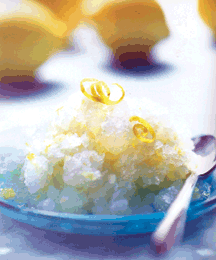
An easy way to zest a lemon is to use a grater with small holes and grate the peel off the lemon directly over a bowl to catch it. Be sure to use only the colored part of the peel. One lemon yields approximately 1 tablespoon zest. Zest is best grated fresh and used immediately.
2 cups water
1- cups sugar
teaspoon salt
2 teaspoons lemon zest
cup fresh-squeezed lemon juice
In a saucepan, bring water to a boil and stir in sugar and salt until dissolved. Cool. Add lemon zest and juice.
Pour into 2 metal ice cube trays with dividers removed, or a metal bowl, or a 9-inch-square baking pan and freeze.
After about 1-1/2 hours, remove from freezer and rake a fork through the ice, to fluff it up.
Return to freezer for about 2 hours.
Remove from freezer about 20 minutes before serving, so ice is easy to scoop.
Makes 4 to 6 servings.


